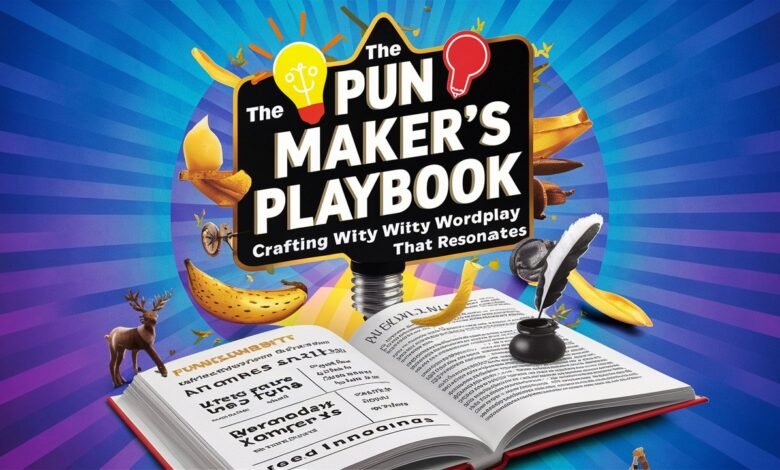The Pun Maker’s Playbook: Crafting Witty Wordplay That Resonates

Introduction: The Delightful Weight of Wordplay
Puns are the glitter of language—sparkly, divisive, and impossible to ignore. To the uninitiated, they’re mere dad jokes; to the pun maker, they’re linguistic alchemy. A well-crafted pun transcends cheap laughs by marrying surprise, relevance, and rhythmic precision. It forces language to bend, revealing hidden connections between disparate ideas. In marketing, literature, or casual banter, puns disarm audiences, making complex messages sticky and relatable. Yet mastering this art demands more than flipping through a rhyming dictionary. It requires an intuitive grasp of semantics, cultural touchstones, and the courage to embrace groans as collateral damage. This article unpacks the anatomy of impactful puns, exploring why they captivate us and how to harness their power with purpose.
1. The Anatomy of a Pun: Layers of Linguistic Subversion
At its core, a pun exploits homophones (words sounding alike, like “knight” and “night”) or polysemy (words with multiple meanings, like “light” as brightness or weight). This duality creates cognitive whiplash—the moment a listener resolves the double meaning, delight (or exasperation) follows. Consider Shakespeare’s grave-digger in Hamlet: “I lie here myself.” Here, “lie” oscillates between reclining and deceiving, mirroring the play’s themes of mortality and deceit. The pun maker’s skill lies in choosing words with semantic elasticity—terms ripe for reinterpretation within a specific context. Without contextual relevance, even clever wordplay feels hollow.
2. Cognitive Alchemy: Why Our Brains Love Puns
Puns thrive on incongruity resolution. When we hear “I’m reading a book on anti-gravity—it’s impossible to put down,” our brains first process the literal meaning. The punchline then forces a sudden reinterpretation (“put down” shifts from placing physically to ceasing reading), triggering dopamine via surprise. Neurologically, this lights up Broca’s area (language processing) and the prefrontal cortex (problem-solving). Evolutionary psychologists argue this mechanism rewards mental flexibility—a survival advantage in pattern recognition. Meanwhile, the groan factor acts as social glue; shared eye-rolls bond people through playful exasperation.
3. The Pun Maker’s Toolkit: Strategies for Maximum Impact
Effective pun-making leverages four pillars: audience awareness, timing, simplicity, and relevance. A tech pun (“Debugging is hard—you might catch a bug!”) lands with developers but may baffle others. Tools like etymology dictionaries reveal word histories (e.g., “avocado” derives from Nahuatl āhuacatl, meaning testicle—fueling endless ripe jokes). For topical puns, monitor trending terms; a bakery might tweet “Doughn’t stop believing!” during a classic rock revival. Crucially, avoid over-punning—diluting impact by stacking multiple puns. One precise strike resonates louder than a scattergun approach.
4. From Clichés to Creative Gold: Elevating Your Pun Game
Move beyond tired tropes (“Pizza my heart”) by mining cultural niches or interdisciplinary hybrids. A marine biologist might quip, “I’m excellent at multi-tasking—I can coral-ate data while kelping students!” Visual puns add dimension: A logo showing an olive with arms (“Olive you forever”) merges image and wordplay. Advanced techniques include recursive puns, where setup and punchline interlock: “A Freudian slip is when you say one thing but mean your mother.” Such layering rewards attentive listeners, transforming wordplay into an intellectual Easter egg hunt.
5. Puns in the Wild: Strategic Applications Beyond Comedy
In branding, puns create mnemonic leverage: Reese’s “Not Sorry” campaign (“Peanut Butter Cups Happen”) reframes accidents as serendipity. Literature uses puns for thematic heft—Vladimir Nabokov’s Lolita hides bilingual puns like “Humbert Humbert” (suggesting French ombre, meaning shadow). Even academia employs them: A paper on procrastination titled “Wait Calculus” boosts recall. Social media amplifies puns’ viral potential; Wendy’s “Rest in Grease” tweet during a rival’s product backlash garnered 2M+ likes by blending wit and savagery.
Conclusion: The Serious Business of Silly Words
Puns are linguistic tightropes—balancing wit and wisdom, simplicity and surprise. When wielded intentionally, they transform communication from transactional to transcendent. A pun maker isn’t just a jester; they’re a cognitive architect, building bridges between sound and meaning, humor and insight. Embrace the groans, refine your craft, and remember: in a world drowning in information, the playful punch of a perfect pun isn’t just funny—it’s unforgettable.
Frequently Asked Questions
Q: Are puns really effective in professional settings?
A: Absolutely—when contextually anchored. A cybersecurity firm’s tagline “Trust us—we’re cryptic experts” reinforces expertise while disarming clients. Avoid puns in high-stakes scenarios (e.g., crisis communications), but use them strategically to humanize brands or clarify complex ideas.
Q: How do I avoid offensive or insensitive puns?
A: Test ambiguities: Could “knead” (in a bakery pun) mishear as “need” in dialects? Avoid puns on sensitive topics (trauma, identity). When in doubt, workshop with diverse audiences.
Q: Can puns work in visual media?
A: Yes—visual puns thrive in logos, ads, or memes. Think: a yoga studio named “Karma Sutra” with a knotted pretzel logo, merging Eastern philosophy and whimsy.
Q: Why do some people hate puns?
A: Overuse breeds fatigue, and forced puns feel disruptive. Critics argue they prioritize cleverness over substance. The fix? Ensure your pun serves a larger message—it should clarify, persuade, or connect, not just show off.
Q: Any tips for beginners?
A: Start with homophone lists (e.g., “sea” vs. “see”). Read poetry—Shakespeare to modern slam—to study rhythm. Finally, listen: Conversations hide accidental puns (“I’m so tired I could nap for years!” becomes “Napoleonic sleeper”).



